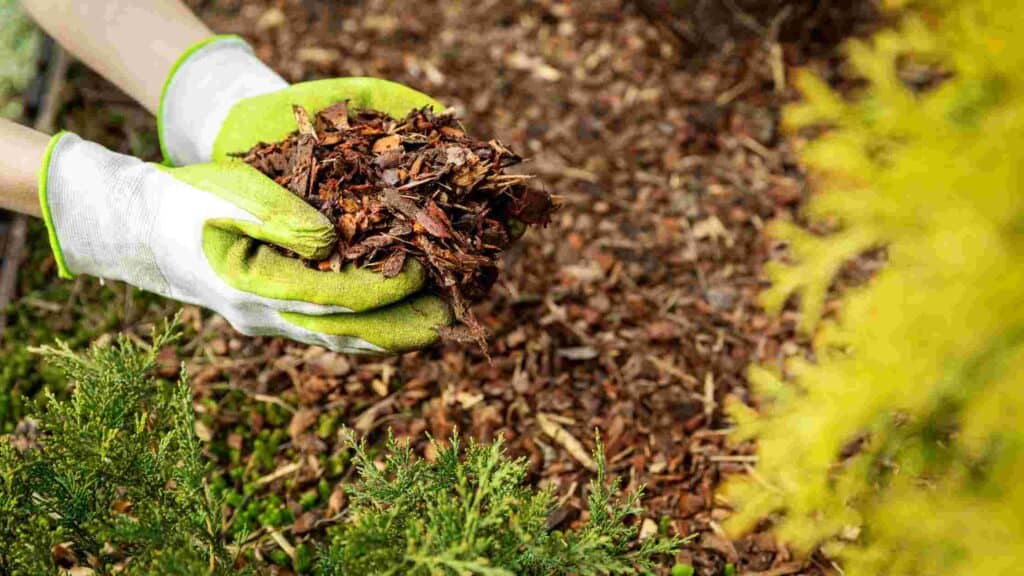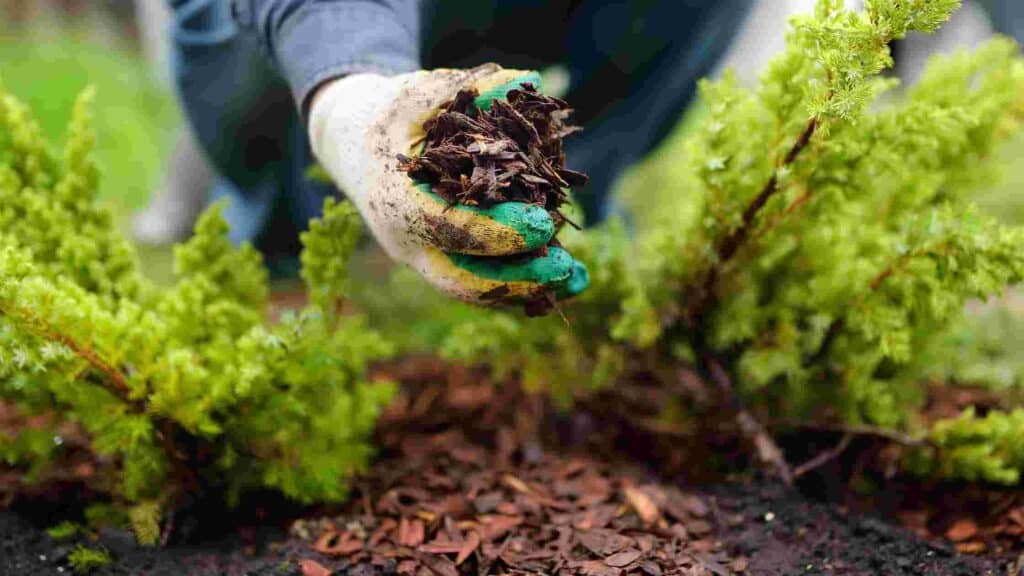In this article, we’ll dive into an essential gardening topic – mulch. So, how often should you replace mulch to keep your garden thriving?
It’s a question many green thumbs ponder.
First things first, what is mulch? Well, it’s important for your garden – a mix of materials like compost, bark, gravel, straw, and more, spread across the soil’s surface. It helps suppress those weeds, maintains stable soil temperatures, and keeps the moisture just right for your precious plants.
Let’s explore the ins and outs of mulch maintenance, including some handy tips to help you make the most of this fantastic gardening tool.
How Often Should You Replace Mulch?
There’s no one-size-fits-all answer when it comes to replacing mulch. Most gardeners aim to swap it out or replenish it every 5 to 6 years, but it’s not set in stone.
Various factors can speed up the process, like the type of mulch you’re using and how the weather’s treating your garden.
When Should You Remove Old Mulch?
So, how do you know when it’s time to replace your mulch? Keep an eye out for signs of discoloration, soil erosion, and decomposition. If you spot any of these, it might be time to consider a refresh.
Don’t worry; it’s all part of the natural cycle. Mulch will eventually break down and stop doing its job as intended.
Some mulches change colors with time, and while they’re still doing their job, they might not be as easy on the eyes. You can spruce things up with fresh mulch.
But, if you’re into dyed mulches, make sure you know how they’re dyed. The environment appreciates it when we opt for natural and eco-friendly options.
How Much Mulch Is Too Much? Calculate Like a Pro!

Before you head to the store or click that “order” button, let’s figure out just how much mulch you’ll need.
Here’s a step-by-step guide that’ll save you both time and money:
Step 1: Measure Your Garden Space
First things first, grab that measuring tape and size up your garden space. Measure the length and width in feet, then multiply those numbers to find the square footage.
If your garden has multiple sections, do the math for each of them. Once you’ve got all those figures, add them up to get the total square footage that needs to be covered.
Step 2: Decide On The Depth
Now, how deep do you want that mulch layer to be? For most flowerbeds and veggie gardens, a cozy 2 to 3 inches is just right (check out: how deep should mulch be?).
But if you’re dealing with stubborn weeds or unruly grass, you might want to go up to 6 inches – that’ll keep them in check!
Step 3: Crunch The Numbers
Multiply the total square footage by the depth you chose. Then, divide the answer by 324 (because one cubic yard of mulch covers 324 square feet). Round it up to the nearest whole number, and you’ll get the amount of cubic yards you need.
Get Rid of Weeds – The Mulch Way!
Weeds! Ugh, they’re like unwanted guests at a party. Here are some extra steps to keep those pesky invaders at bay:
- Landscape Fabric: Use landscape fabric over your soil and top it with a layer of mulch. It’ll create a weed-fighting fortress by blocking out sunlight and thwarting weed growth.
- Vinegar Spray Hack: For those stubborn weeds that dare to pop up, try a vinegar and dish soap mix. It’s an all-natural and wallet-friendly alternative to herbicides.
- Deep Edges: Define your garden with deep edges – it’s like setting a boundary that weeds just won’t cross. Save time, money, and energy on future weed battles!
You may also be interested in checking out how to get rid of mushrooms in mulch.
Should I Remove Mulch Every Year?
You might not always need to go all-out and replace the entire mulch. Sometimes, a little replenishing can do the trick.
Rake the old mulch to even it out, then layer on the new stuff. You can do this every 1 to 2 years – your plants will love it, and you’ll save yourself some effort too!
Switching It Up
Thinking of changing mulch types, like from bark to gravel? Well, if you’re making the switch, go all the way and start fresh.
It’s not just about aesthetics; you want that new mulch to work well without any old remains lingering around.
Mulch Quality
Remember, top-quality mulch will keep your garden looking great. It’ll look fabulous all season long, protect your plants, trees, and shrubs, and keep those weeds at bay.
How Long Does Mulch Last?

Now that you’ve got the amount of mulch you need, let’s talk maintenance – keeping that garden looking fabulous all season long.
Spring Checkup
When spring arrives, take a good look at your mulch. If it’s holding up well and still doing its job, no need to replace it just yet.
But if it’s looking a bit worse for wear – smaller bits and pieces here and there – it’s probably time for a refresh.
Spring And Fall Refresh
To keep your garden happy, check your mulch in both spring and fall. Make sure it’s still 2 to 3 inches thick.
Don’t let the mulch get too close to your trees – pests and rodents love it there, and you don’t want them causing mischief!
FAQs
1. How to go about replacing mulch with rocks?
To replace mulch with rocks, remove the old mulch and prepare the area. Lay a weed barrier fabric to prevent weed growth. Then, spread decorative rocks or gravel evenly on the surface to a depth of 1-2 inches.
2. What to do with old mulch?
You can compost old mulch or use it as a soil amendment in your garden beds. Alternatively, you can dispose of it if it’s heavily contaminated with weeds or pests.
3. Should you remove old mulch before replacing it?
It’s best to remove the old mulch before adding a new layer. This helps prevent excessive build-up and allows for better soil aeration.
4. How often should you mulch your flower beds?
For most flower beds, applying a fresh layer of mulch once a year is sufficient. However, you may need to mulch more frequently if the mulch breaks down quickly or if weeds become a problem.
5. How to replace mulch?
To replace mulch, first, remove the old layer, then prepare the soil surface. Next, spread a new layer of fresh mulch evenly, ensuring a thickness of 2-4 inches.
Conclusion: How Often To Replace Mulch
And there you have it! Armed with the knowledge of how much mulch you need and some nifty maintenance tips, your garden is sure to flourish like never before.
By calculating the perfect amount of mulch and understanding when to refresh or replace it, you’re setting yourself up for gardening success.
Remember, mulch is more than just a pretty cover – it suppresses weeds, keeps your soil cozy, and ensures your plants stay happy and healthy. So, go ahead and give your garden the mulch it deserves, and watch it bloom with beauty!
